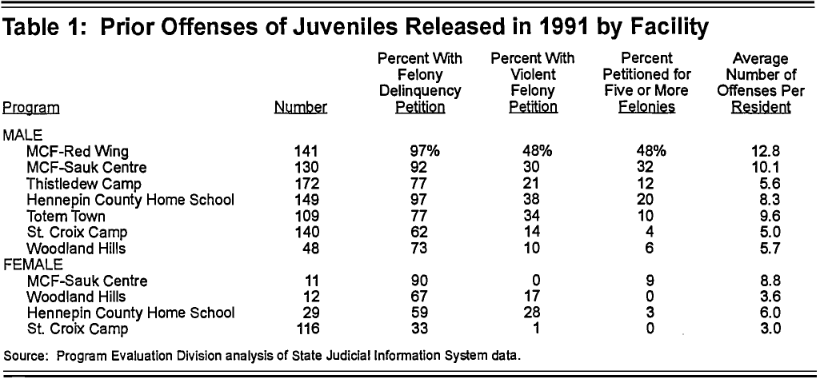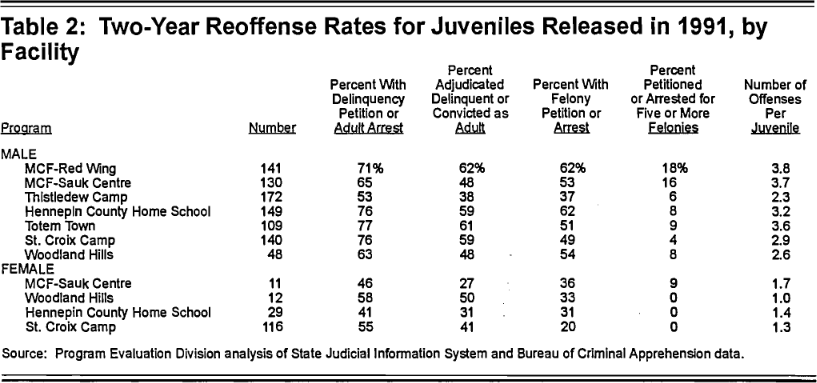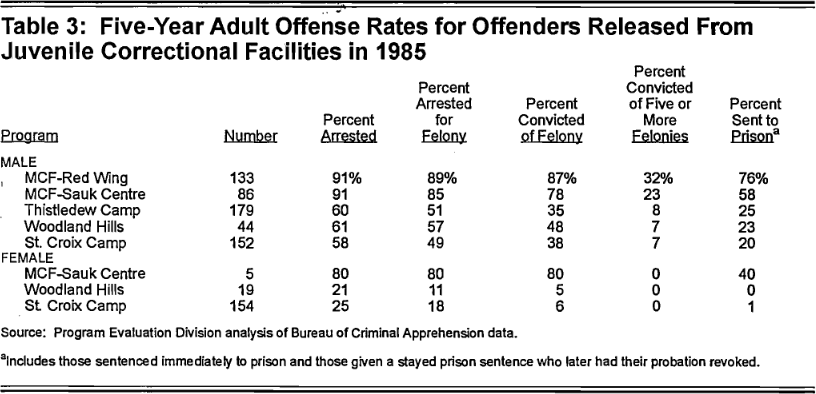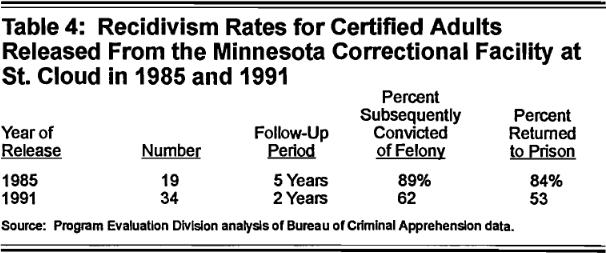February 15, 1995
In recent years, there has been a growing concern nationally and in Minnesota about the rise in juvenile crime. More than 45,000 Minnesota juveniles were arrested for all types of offenses in 1993, and there were 8.3 arrests per 100 Minnesota juveniles ages 10 to 17. Juvenile arrest rates for violent crimes increased significantly over the past decade, both nationally and in Minnesota.
The increase in crime has focused attention on the juvenile justice system, which many people have expected to help change the attitudes and behaviors of young offenders before they become "career criminals." In this study, we looked at large residential facilities that serve juveniles who have been found delinquent by a juvenile court. Most of the juveniles placed in these facilities have previously received community services to address delinquent behavior, and many have been in other residential facilities. We asked:
This is the first systematic study of juvenile recidivism rates in Minnesota using statewide court and law enforcement data. With the cooperation of the State Court Administrator's office, district courts, Bureau of Criminal Apprehension, Department of Corrections, and individual residential facilities, we analyzed reoffense rates for 1,472 offenders released from selected residential facilities in 1991, as well as 791 offenders released from facilities in 1985. We also surveyed the opinions of county correctional supervisors and county social service directors. More than 90 percent of both groups responded.
The Minnesota Department of Corrections (DOC) operates two facilities--at Red Wing and Sauk Centre--that together have capacity to serve more than 200 offenders who have been committed by juvenile courts to the Commissioner of Corrections. These are the only facilities in Minnesota that must admit all offenders referred to them by any of Minnesota's 87 juvenile courts. The department also operates Thistledew Camp in northern Minnesota, and it licenses 10 other "juvenile residential facilities" that are run by county or private operators. Together these 13 facilities have a licensed capacity of over 800 juveniles.
In addition, the Department of Human Services (DHS) licenses about 40 residential treatment facilities for children, mostly privately-operated. These facilities have a total capacity of nearly 1,200, and they serve a variety of children who are delinquent, need protective services, or have emotional disorders. The department has proposed rules that are intended to bring these facilities into compliance with the Minnesota comprehensive children's mental health act. (Minn. Stat. §§245.487-245.4888.)
In many cases, DHS and DOC facilities serve juveniles with similar characteristics and their programs have similar goals. Nevertheless, there are different state rules that govern DHS and DOC facilities, resulting in inconsistent services to residents and potential confusion for persons making placements. In December 1994, the legislatively-established Task Force on Juvenile Programming, Evaluation, and Planning recommended that the two departments work jointly toward consistent requirements for juvenile residential care by July 1997. We strongly concur, and we recommend that:
Many county officials are concerned about the adequacy of the juvenile placement process. For example, most county officials told us in our surveys that they need "much better" information on program effectiveness and the satisfaction of families with facilities. Only 26 percent of social service directors--who typically manage their counties' mental health services--told us that offenders' mental health needs are "always" or "almost always" sufficiently considered prior to placements. Nearly three-fourths of county correctional supervisors said that the presence of waiting lists at preferred facilities "often" or "always" affects their recommendations to juvenile courts regarding placements. County officials said that the population for which they have the most difficulty finding acceptable residential placements are "aggressive, difficult to control offenders."
Our surveys indicated that rehabilitation, or reducing the risk of reoffending, is the preeiminent goal of most Minnesota courts when making placement decisions for juvenile offenders. About 65 percent of county correctional supervisors and 63 percent of social service directors said that rehabilitation is the most important goal of placements. For this reason, it is important to consider the reoffense rates of delinquent juveniles.
Over the past 50 years, there have been hundreds of studies to evaluate the impact of programs for delinquent youth in the United States. We found that:
We looked at the reoffense rates of youth released from seven Minnesota juvenile facilities, including the three operated by the Department of Corrections, two operated by counties (Hennepin County Home School and Ramsey County's Boys Totem Town), and two that are privately operated (St. Croix Camp in Pine County and Woodland Hills in Duluth). Most of the facilities in our sample rely considerably on group-based approaches to encourage juveniles to change their behavior, but the programs differ in length, content, and the characteristics of the offenders they serve. Among juvenile facilities, the Red Wing and Sauk Centre facilities are often considered the "end of the line" for juveniles who have continued to offend after receiving community services and being placed in other residential facilities.
Table 1 shows the numbers and types of offenses committed by our sample of residents prior to their placements. Offenders released from the Minnesota Correctional Facility (MCF) at Red Wing had more prior offenses and more serious offenses, on average, than juveniles released from the other facilities. It is likely that, without treatment, offenders with lengthier prior records would be more apt to reoffend than other offenders, but we cannot be certain of this.

Table 2 presents our findings on the reoffense rates for juveniles released from selected "long-term" programs in 1991. All of the programs shown exceeded three months in length. We found that: One-half to three-quarters of males were petitioned in juvenile court or arrested for crimes as adults in the two years following their release from juvenile facilities.

Table 2 shows that between 53 and 77 percent of males were petitioned or arrested, between 37 and 62 percent for felonies. Reoffense rates tended to be lower in facilities that served offenders with shorter or less serious prior offense histories, and we found that some of the differences in recidivism rates among facilities diminished when we limited our analysis to offenders who had previously been chronic or violent offenders. We also found that female offenders tended to reoffend at lower rates than male offenders. Minnesota's reoffense rates for the two years immediately following release appear to be within the broad range of rates reported for residential programs in other states.
Many people hope that even if juveniles reoffend in the short term, they will become law-abiding citizens by the time they are adults. In fact, many believe that the threat of sanctions in adult courts will discourage juveniles from continuing their criminal activities into adulthood. For offenders released from five juvenile facilities in 1985, we examined criminal records during their first five years of adulthood. We found that:As shown in Table 3, the rates for juveniles released from Sauk Centre and Red Wing were higher than those at three other Minnesota facilities that we examined, although Sauk Centre and Red Wing have tended to admit juveniles with more prior offenses than have the other facilities. Two facilities that we examined in our analysis of juveniles released in 1991 (Hennepin County Home School and Boys Totem Town) were unable to provide us with lists of residents released in 1985. These findings relate to juveniles released from facilities 10 years ago, and there have been various changes to these programs during that time. However, the extremely high rates of adult offense underscore the importance of continuing to monitor rates for youth served in more recent years. For males age 17 or older released in 1991, we found that 61 percent of Red Wing offenders were arrested for offenses as adults during their first one to two years of adulthood, and three other facilities (Hennepin County Home School, Boys Totem Town, and Sauk Centre) had adult arrest rates of at least 44 percent during this follow-up period.

Finally, we examined rates of reoffense among juvenile offenders who had been "certified" as adults and sent to the Minnesota Correctional Facility at St. Cloud. As shown in Table 4, we found that:

These offenders were apparently not sufficiently deterred from criminal behavior by the experience of living in prison and the threat of reincarceration for subsequent offenses.
Although we do not know how many juveniles would have reoffended if they had not participated in a residential program, the high rates of reoffense that we found are disappointing. The rates likely underestimate the true reoffense rate by excluding persons who offended but were not caught or who committed offenses in other states. The factors contributing to these high rates are complex and likely include broad societal problems, such as family dissolution, as well as inadequacies in services for offenders. In order to reduce juvenile recidivism, it may be necessary to consider improvements in community-based early intervention services, residential programs, and community services for offenders who have completed residential placements.
We think it is also important to have better information on the outcomes of services to Minnesota's youthful offenders. Regular reporting on rates of juvenile reoffense could help to (1) create incentives for improved performance by service providers, and (2) improve the information available for legislative discussions and decisions. We recommend that:
At the request of the Legislature, we surveyed county officials to determine their perceptions of residential programs for juvenile offenders. In general, county officials told us that they prefer to use programs that hold juveniles accountable, have committed staff, work effectively with families of offenders, and provide individualized services. Many officials believe there is considerable room for improvement in Minnesota's system of residential facilities. For example 74 percent of social service directors and 44 percent of correctional supervisors told us that residential facilities "sometimes," "rarely," or "never" make sufficient efforts to work with the families of offenders. We found that:
This facility has a relatively short program (13 to 15 weeks) and combines wilderness survival activities with school instruction and work assignments. It also tends to serve juveniles whose history of offending is less extensive than some other facilities we examined.
Counties tended to have less positive ratings of the Sauk Centre and Red Wing facilities. It is possible that county concerns about these facilities partly reflect the fact that they tend to serve more chronic and more serious offenders than other programs. These may be offenders who are less amenable to rehabilitation. However, we also found that these facilities have lower staffing levels and shorter stays than many other facilities for juvenile offenders that we reviewed. For example, Department of Corrections licensing staff estimate that the Red Wing facility would need 12 additional staff and Sauk Centre would need 3 staff to meet the minimum staffing levels required by state rules, which are met by all other DOC-licensed facilities. This could limit the ability of these facilities to try more individualized, intensive, and creative approaches with offenders whose behaviors have not been changed by other programs. Partly because of concerns about the adequacy of programs and security at these facilities, Minnesota's largest counties have placed some of their more difficult offenders at facilities in other states.
Department of Corrections officials questioned whether county officials understand facility programs well enough to rate them accurately. We think that, at a minimum, the concerns expressed to us about Sauk Centre and Red Wing reflect a lack of confidence among some placing counties that should be addressed. We recommend that:
Our study indicated that there is room for improvement in existing residential programs for juvenile offenders, and there may be a need for better community services for juveniles after they return home. However, improving these services will not prevent juveniles from becoming delinquents in the first place. In 1994, a Minnesota Supreme Court task force said that, "(T)he ultimate solution to juvenile crime lies in the strengthening of families and communities, and the implementation of prevention and early intervention programs." Report of the Minnesota Supreme Court Advisory Task Force on the Juvenile Justice System (St. Paul, January 1994), 3. The task force also recommended another approach--stricter juvenile sanctions--which the 1994 Legislature enacted into law. For example, the Legislature established a category of offenders, known as "extended jurisdiction juveniles," for whom the courts shall impose both a juvenile disposition and a stayed adult criminal sentence. If such an offender violates the conditions of the stayed sentence before age 21, the court may impose the adult sanctions.
All of these options represent legitimate responses to the problem of juvenile crime. Our study, at the request of the Legislature, focused primarily on residential facilities, which represent only one portion of the justice system's response to juvenile crime. A broader analysis would be required in order to determine whether Minnesota has implemented the proper mix of services: preventive and corrective, residential and nonresidential.
We found that Minnesota's residential programs have not stopped most of their residents from committing further offenses, often serious ones. Perhaps it is unrealistic to expect that programs lasting several months can permanently change longstanding attitudes and behavior patterns in juveniles who have not been changed by prior interventions. But there are significant, long-term fiscal consequences if Minnesota's juvenile strategies cannot be made more successful. A task force recently projected that the state would have to spend more than $30 million to construct 325 additional prison beds over the next decade, assuming that 25 percent of extended jurisdiction juveniles will be sent to prison following a new offense or a violation of parole or probation. Report of the Task Force on Juvenile Programming, Evaluation, and Planning (St. Paul, December 1994), 44. Our findings indicate that a 25 percent reoffense rate would be considerably below current rates of reoffense for serious offenders. If actual reoffense rates are higher, Minnesota may have to consider further expansions of prison space. We think it will be important for policy makers to closely monitor the impact of the extended jurisdiction juvenile legislation, as well as the success of individual programs in changing the behaviors of serious offenders.
The Program Evaluation Division was directed to conduct this study by the Legislative Audit Commission on June 22, 1994 as requested by Minn.Laws (1994), Ch. 576 (the "Juvenile Crime Bill of 1994").
This report won a 1998 Impact Award from the NCSL National Legislative Program Evaluation Society.
For a copy of the full report, entitled "Residential Facilities for Juvenile Offenders" (95-01), 136 pp., published on February 15, 1995, please call 612-296-4708, e-mail our office at Legislative.Auditor@state.mn.us, or write to the Office of the Legislative Auditor, 658 Cedar St., St. Paul, MN 55155.